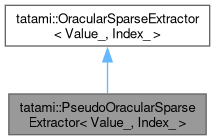Mimic the OracularSparseExtractor interface.
More...
#include <PseudoOracularExtractor.hpp>


Public Member Functions | |
| PseudoOracularSparseExtractor (std::shared_ptr< const Oracle< Index_ > > oracle, std::unique_ptr< MyopicSparseExtractor< Value_, Index_ > > ext) | |
| SparseRange< Value_, Index_ > | fetch (const Index_, Value_ *const value_buffer, Index_ *const index_buffer) |
 Public Member Functions inherited from tatami::OracularSparseExtractor< Value_, Index_ > Public Member Functions inherited from tatami::OracularSparseExtractor< Value_, Index_ > | |
| SparseRange< Value_, Index_ > | fetch (Value_ *value_buffer, Index_ *index_buffer) |
Detailed Description
struct tatami::PseudoOracularSparseExtractor< Value_, Index_ >
Mimic the OracularSparseExtractor interface.
- Template Parameters
-
Value_ Data value type, should be numeric. Index_ Row/column index type, should be integer.
This is used to quickly implement the sparse extraction methods for a Matrix subclass that does not benefit from an Oracle. Specifically, the oracle is used to generate a prediction that is passed to an oracle-unaware MyopicSparseExtractor. This allows Matrix subclasses to satisfy the sparse oracle-aware extraction interface without much effort.
Constructor & Destructor Documentation
◆ PseudoOracularSparseExtractor()
|
inline |
- Parameters
-
oracle The oracle. ext A sparse extractor to extract dimension elements according to ora.
Member Function Documentation
◆ fetch()
|
inlinevirtual |
This overload is intended for developers only. It introduces the i argument so that the signature is the same as that of MyopicSparseExtractor::fetch(). This makes it easier to define MyopicSparseExtractor and OracularSparseExtractor subclasses from a single template, avoiding code duplication that would otherwise occur when defining methods with and without i. Of course, implementations are expected to ignore i in oracle-aware extraction.
Other than the extra i argument, all other behaviors of the two overloads are the same. To avoid confusion, most users should just use the fetch() overload that does not accept i, given that the value of i is never actually used.
- Parameters
-
i Ignored, only provided for consistency with MyopicSparseExtractor::fetch().[out] value_buffer Pointer to an array with enough space for at least Nvalues, whereNis defined as described forMyopicDenseExtractor::fetch().[out] index_buffer Pointer to an array with enough space for at least Nindices, whereNis defined as described forMyopicDenseExtractor::fetch().
- Returns
- A
SparseRangeobject describing the contents of the next dimension element, as predicted by theOracleused to construct this instance.
Implements tatami::OracularSparseExtractor< Value_, Index_ >.
The documentation for this struct was generated from the following file:
- tatami/utils/PseudoOracularExtractor.hpp
Generated by